Naubat Khan
Naubat Khan (also known as Ali Khan Karori) was a prominent Indian classical music composer, musician and instrumentalist. He was an influential musician of his time. The rudra veena, also called the bin, came into prominence during the time of Tansen's contemporary, and son-in-law, Naubat Khan. In the paintings of the time, it is clearly Naubat Khan and not Tansen who is associated with the instrument.[1] Naubat Khan was the honorary title conferred by Mughal Emperor Jahangir on Ali Khan Karori.[2]
Naubat Khan | |
|---|---|
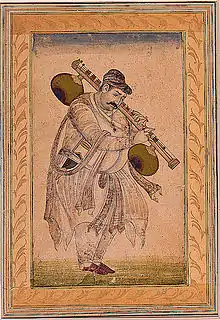 Portrait of Naubat Khan Kalawant, San Diego Museum of Art, Edwin Binney 3rd Collection | |
| Background information | |
| Birth name | Misri Singh |
| Born | Kishangarh, Rajasthan |
| Genres | Hindustani Classical Music |
| Occupation(s) | Karori, Beenkar, Classical Mughal Era Musician, Darogha of Naqqar Khana |
Early life and background
Naubat Khan was the grandson of Raja Samokhan Singh of Kishangarh, and the son-in-law of the legendary Tansen.[3] Samokhan Singh, a Jodhpur prince, was himself a great veena player of his time.[4] He was defeated by the forces of the Mughal emperor Akbar, and his grandson Misri Singh (Naubat Khan) was kept under house arrest. Misri Singh later accepted Islam[5] and was named Ali. He was trained under Abdul Rahim Khan-I-Khana, the son of Bairam Khan to get an understanding of the Mughal court procedures. Ali was given the title of Khan by Akbar, and the post of Karori, i.e. Collector of revenue. He was later given the prestigious position of the darogha of the Naqqar Khana. As mentioned in Tuzk-e-Jahangiri, Ali Khan Karori was given the title of Naubat Khan and rank of 500 personnel and 200 horse on 14 Rabi ul Awwal 1016 Hijri(Monday 9 July,1607,Gregorian), during Jahangir's visit to Kabul.[6][7][8]
Marriage with Saraswati
Naubat Khan first married Ahmad Khan Mughal's daughter. After his first wife's death, he married Tansen's daughter, Saraswati. Saraswati accepted Islam and was named Hussaini. They had a son named Lal Khan. Lal Khan was the son-in-law of Tansen's son Bilas Khan.[9] Lal Khan was the chief musician of Emperor Shahjahan.[10] Shahajahan conferred on him the title of Gunsamundra.
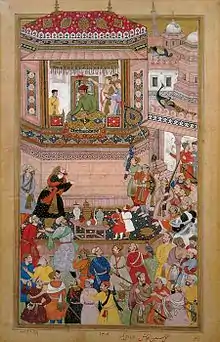
Subject of individual portrait

Only highly ranked figures of the court enjoyed the privilege of being painted alone or within an assembly by the painters of the court and Naubat Khan is one of the rare musicians – along with the illustrious singer-composer Tansen – to have been the subject of an individual portrait. Both Tansen and Naubat Khan were individually immortalized by artists of the Imperial atelier during the reign of Mughal Emperor Akbar. A superb and well-known portrait of Naubat Khan painted during Akbar's reign and attributed to the artist Mansur, is held in the British Museum. Another lively tinted drawing of him is in the Museum of Fine Arts, Boston and yet another from the Edwin Binney 3rd Collection is presently held in the San Diego Museum of Art. [11]There is yet another portrait of Naubat Khan which is a Double Sided Muraqqa Folio.The influential musician Naubat Khan playing a rudra vina, or bin, with its large round orange gourds, wearing an Akbar period white muslin chakdar (four pointed) jama with a small white kulhadar (an early Akbar-style turban) on his head, stands on a slash of green landscape. A flat verdigris background with a hint of blue sky above. The nasta'liq script on the applied album folio on the verso reads:
"chand gu'i ze koja'i o koja az nahan-khaneh-ye tajridam o az deyr fana to jadal mi-koni amma che-koni chun na-koni goft haqq dar haqq-e to akthar-e shay' jadala".
Translation:
"How many times will you ask: Where are you? Where are you? Where? I am from the closet of separation and from the transitory world. You dispute, but what will you achieve if you do not?
He said: Truth, you will always be the cause of disagreement".
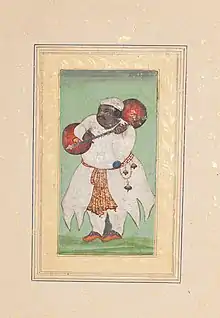
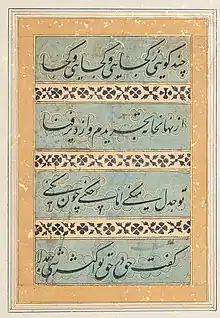
Beenkar dynasty
Naubat Khan was the founder of the Beenkar dynasty of India. His direct descendants commanded respect in musical circles for several centuries. Notable members of this family are
- Lal Khan Gunsamundra (Chief musician of Shahjahan, son-in-law of Tansen's son Bilas Khan)[9]
- Khushal Khan Gunsamundra (Title of Gunsamundra conferred by Shahjahan,Chief musician at the court of Mughal Emperor Shahjahan and Mughal Emperor Aurangzeb).
- Bisram Khan (Son of Lal Khan Gunsamundra, One of the Chief musicians at the court of Mughal Emperor Shahjahan and Mughal Emperor Aurangzeb).
- Bhupat Khan[12]
- Sadarang(Chief musician of Mughal Emperor Muhammad Shah)
- Adarang[13]
- Sidhar Khan[14]
- Omrao Khan Beenkar[15]
- Ameer Khan
- Wazir Khan (Master of Hamid Ali Khan of Rampur, Allauddin Khan, Hafiz Ali Khan, Vishnu Narayan Bhatkhande)
- Dabir Khan
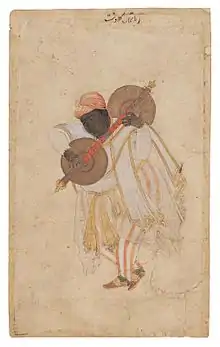
See also
References
- Bonnie C. Wade (January 1998). Imaging Sound: An Ethnomusicological Study of Music, Art, and Culture in Mughal India. University of Chicago Press. p. 119. ISBN 978-0-226-86841-7.
- Jahangir (Emperor of Hindustan) (1989). The Tūzuk-i-Jahāngīrī, Or, Memoirs of Jahāngīr. Low Price Publications. p. 111. ISBN 978-81-85395-13-5.
- Stephen Slawek (1987). Sitār Technique in Nibaddh Forms. Motilal Banarsidass. p. 17. ISBN 978-81-208-0200-1.
- Sunita Dhar (1989). Senia gharana, its contribution to Indian classical music. Reliance Pub. House. p. 13. ISBN 978-81-85047-49-2.
- Rosemary Crill; Kapil Jariwala (2010). The Indian Portrait, 1560-1860. Mapin Publishing Pvt Ltd. p. 70. ISBN 978-81-89995-37-9.
- Bonnie C. Wade (January 1998). Imaging Sound: An Ethnomusicological Study of Music, Art, and Culture in Mughal India. University of Chicago Press. p. 120. ISBN 978-0-226-86841-7.
- "London's Portrait Gallery showcases Mughal art". Rediff. 4 June 2010.
- Bonnie C. Wade (January 1998). Imaging Sound: An Ethnomusicological Study of Music, Art, and Culture in Mughal India. University of Chicago Press. p. 120. ISBN 978-0-226-86841-7.
ali khan karori.
- Vijaya Moorthy (2001). Romance of the Raga. Abhinav Publications. p. 27. ISBN 978-81-7017-382-3.
- "romance of raga lal khan gunsamudra - Google Search". google.co.in.
- "Rudra-Vina, The musicians - The Mughal period". rudravina.com.
- "Bhupat Khan - Oxford Reference". oxfordreference.com. ISBN 9780195650983.
- "Who were Sadarang and Adarang?". gktoday.in.
- "Artist - Siddhar Khan (Tabla), Gharana - Delhi". swarganga.org.
- Allyn Miner (April 2004). Sitar and Sarod in the 18th and 19th Centuries. Motilal Banarsidass. p. 97. ISBN 978-81-208-1493-6.
umrao khan tansen.